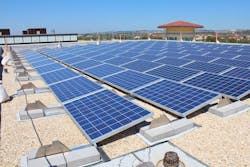A Tool to Help Home Microgrids Stay Off Grid as Long as Possible
Researchers at the University of Texas San Antonio (UTSA) have developed an optimization tool for microgrids that allows homes to stay off grid as long as possible, generally using solar, storage and smart meters.
The researchers recently received a patent from the US Patent and Trademark Office, based on a grant from the US Department of Energy.
The tool aims to optimize the use of solar, storage, electric vehicles and other loads and resources to ensure a building remains off grid as long as possible, as inexpensively as possible, said Brian Kelley, associate professor in UTSA’s electrical and computer engineering department.
Called Power Quality of Service Optimization for Microgrids, the tool decides when to use solar or other renewable energy systems, when to store it, and when to rely on power from the grid.
“There are statistics and predictions you can use for when clouds will be overhead or when cloudy days will occur. These variables can be fed into the optimization,” he explained. “If you see a cloudy day tomorrow, you could increase the amount of storage today.”
Increasing use of pure renewables
The variables that determine how long a homeowner or business can be off grid depend on the size of the renewable energy system, likely solar.
“By increasing the rated capacity of the renewable source and energy storage, you can get increasingly high utilization of pure renewables,” he said. “This invention allows you to do that as inexpensively as possible.”
The system also can control various loads, including household appliances, electric vehicle charging and lights, scheduling the best time to serve those loads.
That’s one of the features that makes the system unique, said Kelley. When certain loads are not needed, the system can stop delivering power to them if the power is needed elsewhere.
“There are schedulers and smart meters and mission control systems that make this unique,” he said.
Electric vehicles could be added to the system and charged when prices are lowest. And batteries from the vehicles could be used as added storage for the household — when the vehicle is not being driven. What’s more, solar could power electric vehicles. Kelley and his associates are looking into getting a National Science Foundation grant to study these possibilities in more depth.
The product is not meant to be used for net metering. The goal is to have as little impact as possible on the grid, said Kelley.
“The invention was designed with the notion of trying not to disturb the utility grid, with low as frequency as possible,” he said.
The least expensive way to build a microgrid that takes advantage of the system is to use flow batteries, said Kelley. While the system the researchers patented doesn’t include any specific renewable energy or storage systems, one of Kelley’s students has studied the advantages of flow batteries.
“The great thing about this battery is that it offers almost unlimited capacity by using large storage tanks.” The tank could be located underground, he noted.
Increasing the size of the tank provides for more storage. With lithium ion batteries, increasing capacity means adding more batteries, which is generally more expensive.
Networking off grid microgrids
The researchers’ system was designed to be used with a microgrid for one or a few buildings. But in the future, it’s possible the microgrids could be networked together, which would provide advantages.
“This invention assumed a single microgrid island,” Kelley says. “We started looking at multiple microgrid islands. It depends on how far apart they are. If you have solar or wind resources sufficiently far apart, the random power fluctuations of the solar and wind start to be independent of each other.” That means that networking the microgrids would improve their overall performance, he explains. When one microgrid lacked solar, another microgrid might have plenty of renewable energy available to share.
Microgrids that allow homes to operate separately from the grid much of the time would provide needed resiliency, according to a press release from UTSA.
On June 6, more than 3,400 lightning strikes and high winds knocked out power to about 57,000 residents in San Antonio, the release said.
“The whole idea is to design a system around using principally renewables and storage to avoid having to use the utility grid,” said Kelley.
Track news about home microgrids. Subscribe to the free Microgrid Knowledge newsletter.
About the Author
Lisa Cohn
Contributing Editor
I focus on the West Coast and Midwest. Email me at [email protected]
I’ve been writing about energy for more than 20 years, and my stories have appeared in EnergyBiz, SNL Financial, Mother Earth News, Natural Home Magazine, Horizon Air Magazine, Oregon Business, Open Spaces, the Portland Tribune, The Oregonian, Renewable Energy World, Windpower Monthly and other publications. I’m also a former stringer for the Platts/McGraw-Hill energy publications. I began my career covering energy and environment for The Cape Cod Times, where Elisa Wood also was a reporter. I’ve received numerous writing awards from national, regional and local organizations, including Pacific Northwest Writers Association, Willamette Writers, Associated Oregon Industries, and the Voice of Youth Advocates. I first became interested in energy as a student at Wesleyan University, Middletown, Connecticut, where I helped design and build a solar house.
Twitter: @LisaECohn
Linkedin: LisaEllenCohn
Facebook: Energy Efficiency Markets

